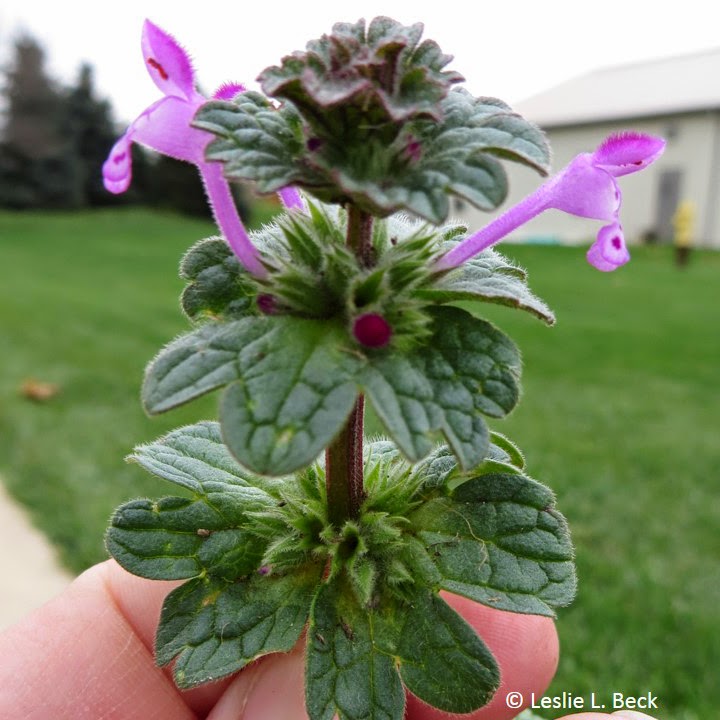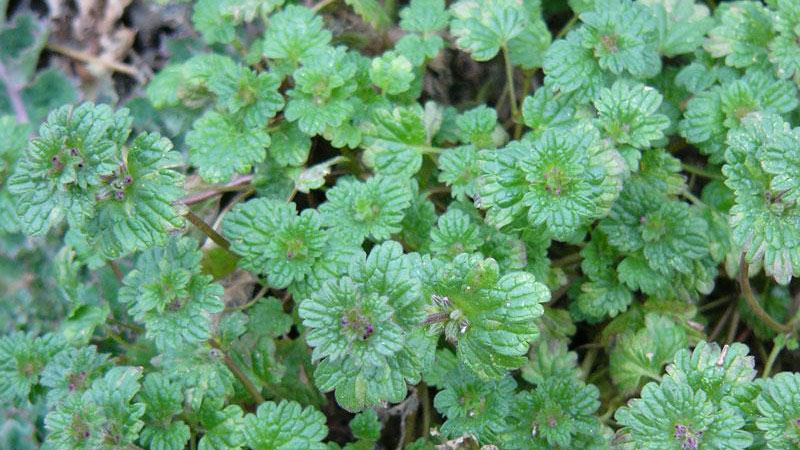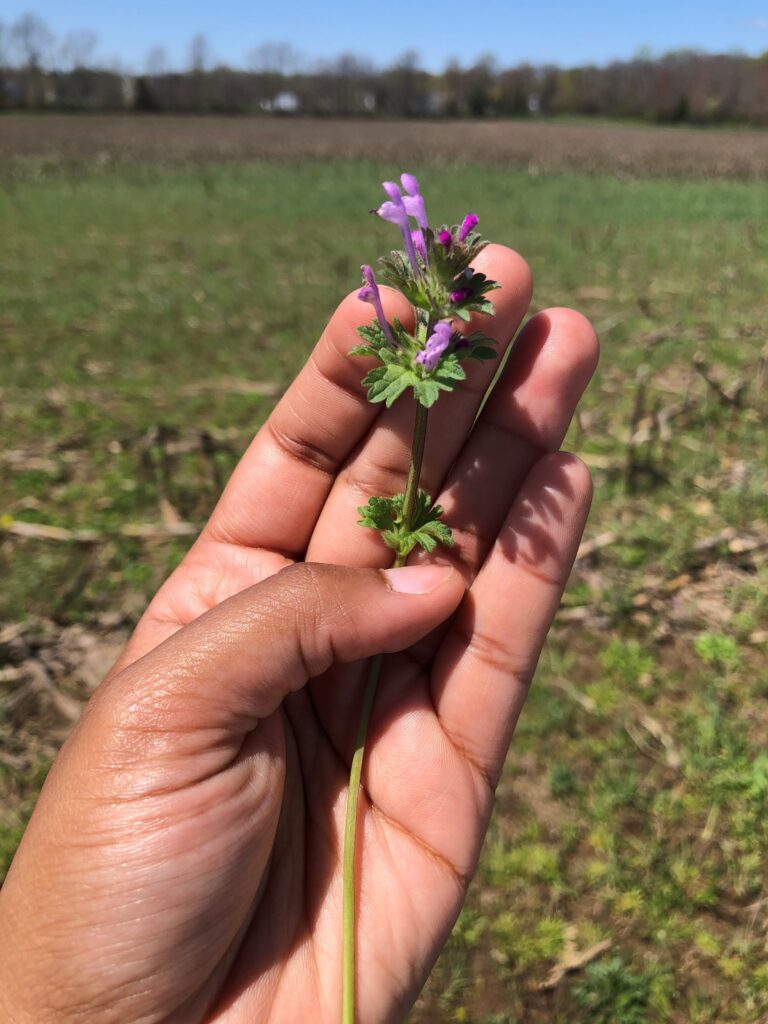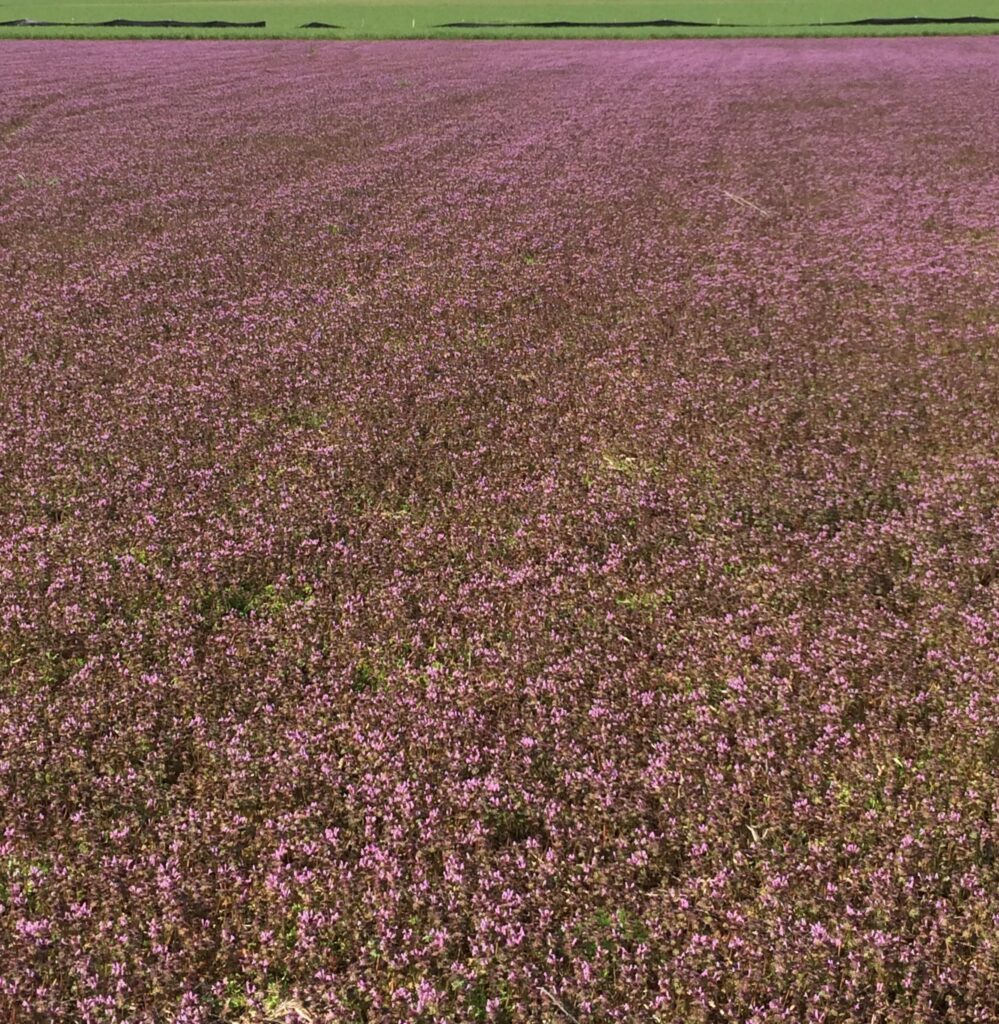Main Content

Henbit (Lamium amplexicaule) is a widespread winter annual weed whose square stem, unique leaf shape, and showy pink to purple flowers in spring make it easily recognizable.
Importance as an Agricultural Weed
As a winter annual, henbit is a common weed of fall and spring planted cereal grain crops. Henbit is primarily a weed of no- or reduced-till systems as small plants are easily killed by tillage and seed survival is reduced with tillage. This weed prefers the light, sandy soils typical of farms throughout the county. Although henbit is not a particularly competitive weed, severe infestations can reduce yield of winter grains. Henbit is also an alternate host for soybean cyst nematode, two-spotted spider mite, and tomato spotted wilt virus.
Key Characteristics for Identification
| Characteristics | Description |
| Overall Appearance | Short, sprawling growth habit (will root at nodes) Square stems are green to purple Stem internodes shorten in flowering portions Plants reach 4-16″ in height |
| Leaf Attributes | Prominent veins and crinkled appearance of leaf surface Lower leaves – petiolated, rounded to heart-shaped, rounded teeth on leaf edge Upper leaves – sessile (lacking petioles) and encircle the stem, deep lobes |
| Presence of Hairs | Hairs on upper leaf surface and along veins on lower leaf surface Dense hair on young stems but stems are nearly hairless at maturity |
| Flowers | Full bloom in April (sporadically flowers March-November) Pink to purple flowers protrude in a whorl pattern from the axils of upper leaves Petals unite to form a tube |
Henbit is commonly confused with purple deadnettle, another winter annual weed with crinkled leaves and purple flowers. Both weeds are managed similarly, but purple deadnettle has triangular leaves with less lobing and the upper leaves are reddish-purple.
Chemical Control Options
For herbicide recommendations, refer to the following publications. Additional commercial crop production guides can be found here. Contact your local county Extension office with specific questions.
- Field Crops: Mid-Atlantic Field Crop Weed Management Guide
- Vegetable Crops: Mid-Atlantic Commercial Vegetable Production Recommendations
- Turfgrass: NJAES Factsheet 385 Broadleaf Weed Control in Cool Season Turfgrasses
- Home Landscape: NJAES Bulletin 272 Weed Management in Ornamental Plantings
Integrated Weed Management Strategies
Fall emerged henbit is easily killed with tillage. However, tillage in late fall may be unfavorable due to soil conditions and risk of soil exposure to erosion. Flame weeding is one alternative that can kill emerged henbit without soil disturbance. Some henbit may emerge in spring; tillage can be used to kill these plants in April and early May but fall emerged plants will have already set seed. Each plant can produce 200-2,000 seeds.
Fall cover crops that establish quickly and provide excellent ground cover (e.g., cereal rye, radish, etc.) can diminish establishment of henbit. This weed does not tolerate shade so consider earlier planted cover crops such as winter hardy clover to prevent henbit establishment. The lack of fall tillage will reduce henbit germination and low light conditions under the cover crop canopy are unfavorable for henbit establishment.
- In vegetable systems: Tillage preceding and following an early crop of lettuce can help to break the life cycle of this weed.
- In small grain systems: Delay tillage and planting of fall grains to the middle of the planting window to kill fall germinating henbit prior to grain establishment. Tine weeding after crop establishment can aid in control but plan to seed the grain at a high rate to compensate for any crop damage due to cultivation. Plant spring grains as early as possible to promote crop establishment before peak emergence of spring germinating henbit.



References
Anonymous. Henbit. Michigan State University. https://www.canr.msu.edu/weeds/extension/henbit.
Mohler, C.L., Teasdale, J.R., & DiTommaso, A. (2021). Major agricultural weeds of the United States and Canada: Broadleaf weeds and their relatives. In L. Barba (Ed.), Manage weeds on your farm: A guide to ecological strategies. Sustainable Agriculture Research and Education.
Patton, R. & Beck, L. Henbit. Purdue University, Turfgrass Science. https://turf.purdue.edu/henbit/.
Peacock, C. (2017, November 21). Henbit. North Carolina State Extension. https://content.ces.ncsu.edu/henbit.
Uva, R.H., Neal, J.C., & DiTomaso, J.M. (1997). Weeds of the Northeast. Cornell University Press.